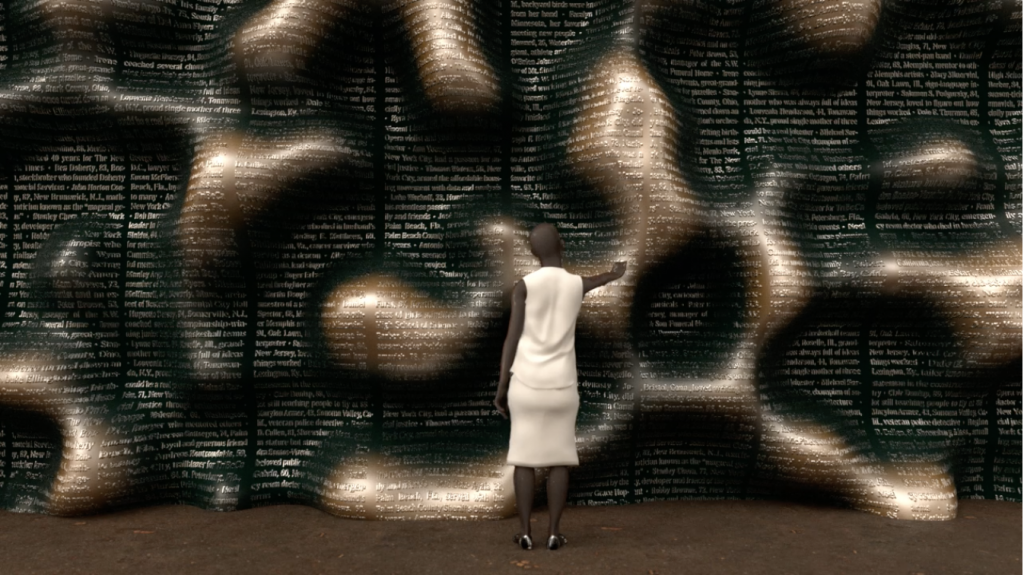Many people associate the beginning of the 20th century with World War I, an unprecedented time where American men were sent to fight by the hundreds of thousands on shores abroad, and new scientific developments were made in the name of warfare. However, very few are aware of the reason behind the deaths of at least fifty million people during this time (“Influenza”). The 1918 Influenza Pandemic is largely forgotten in the shadow of the Great War, even though the number of its victims far supersede those of war casualties. Millions of troops moving overseas totally exacerbated the spread of this disease, causing multiple waves of infection.
How could a catastrophe of this magnitude escape the minds of almost everyone today? Our society tries not to forget tragedies by honoring those affected, but sometimes we fail to remember even the most profound ones. The absence of cultural responses at the time to this pandemic has baffled historians (Honigsbaum). Compared to our current COVID-19 pandemic, the trends are eerily similar. Could this set the stage for how we will remember COVID-19 in the future?
How have previous pandemics been commemorated?
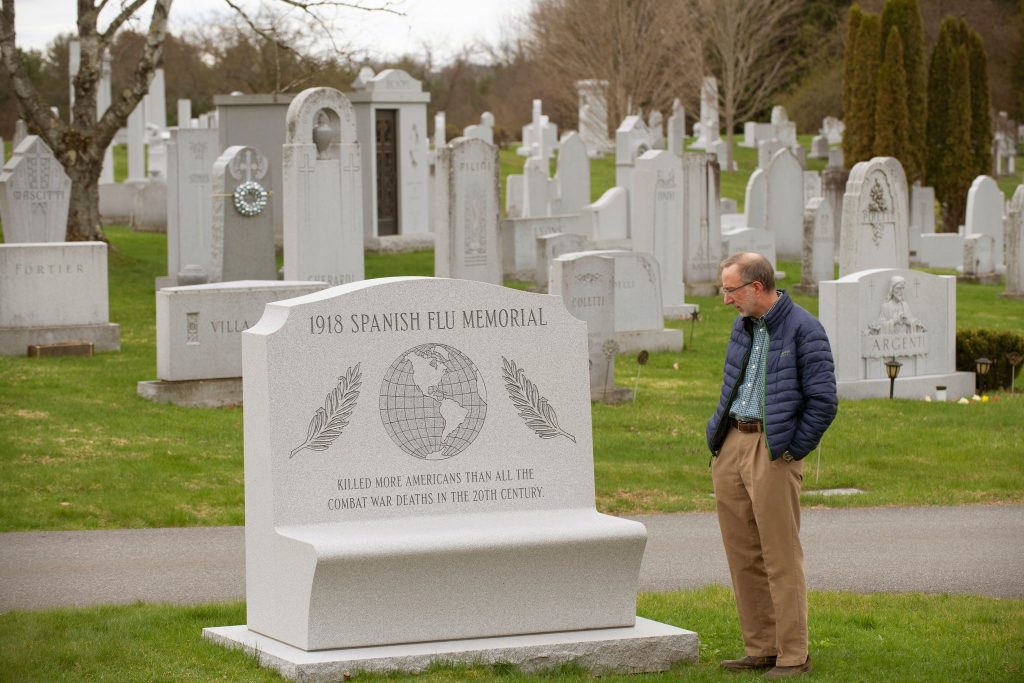
The 1918 Influenza Pandemic has only recently been commemorated at Hope Cemetery in Barre, Vermont in 2018. In the cemetery, a white granite bench is placed afar from the other headstones and it measures five feet high and three feet deep. The text, “1918 Spanish Flu Memorial – Killed More Americans Than All the Combat War Deaths in the 20th Century” is inscribed on the front and the phrase “Over 50 million deaths worldwide” on the back (Segal).
(Segal)
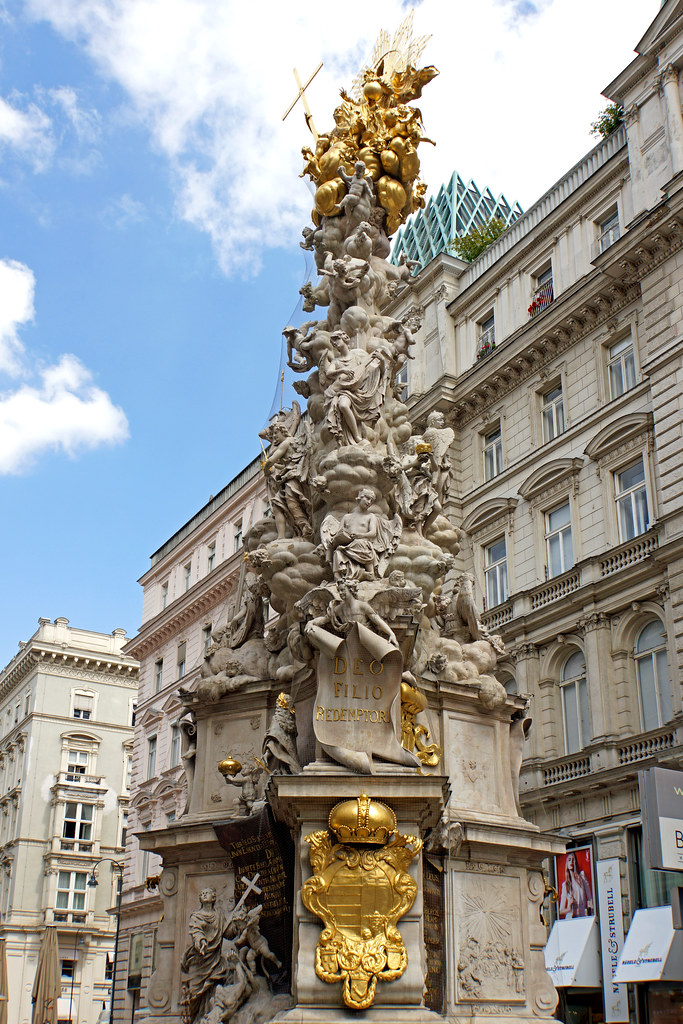
In Klagenfurt, Austria an eighteenth-century plague column sits in the center of a busy intersection, created in 1965. The Bubonic plague broke out numerous times in the eastern hemisphere between the 6th century B.C. and the 19th century from the spread of fleas carried by rats. This plague killed nearly 25 million people over this span of time and there were many religiously centered artistic responses because of it. Plague columns and some small churches in Europe were originally erected to thank God for lifting the plague (Shanken and Godbey). Klagenfurt’s plague column does not serve as a reminder of the plague but emphasizes the importance of the town’s history.
(Jarvis)
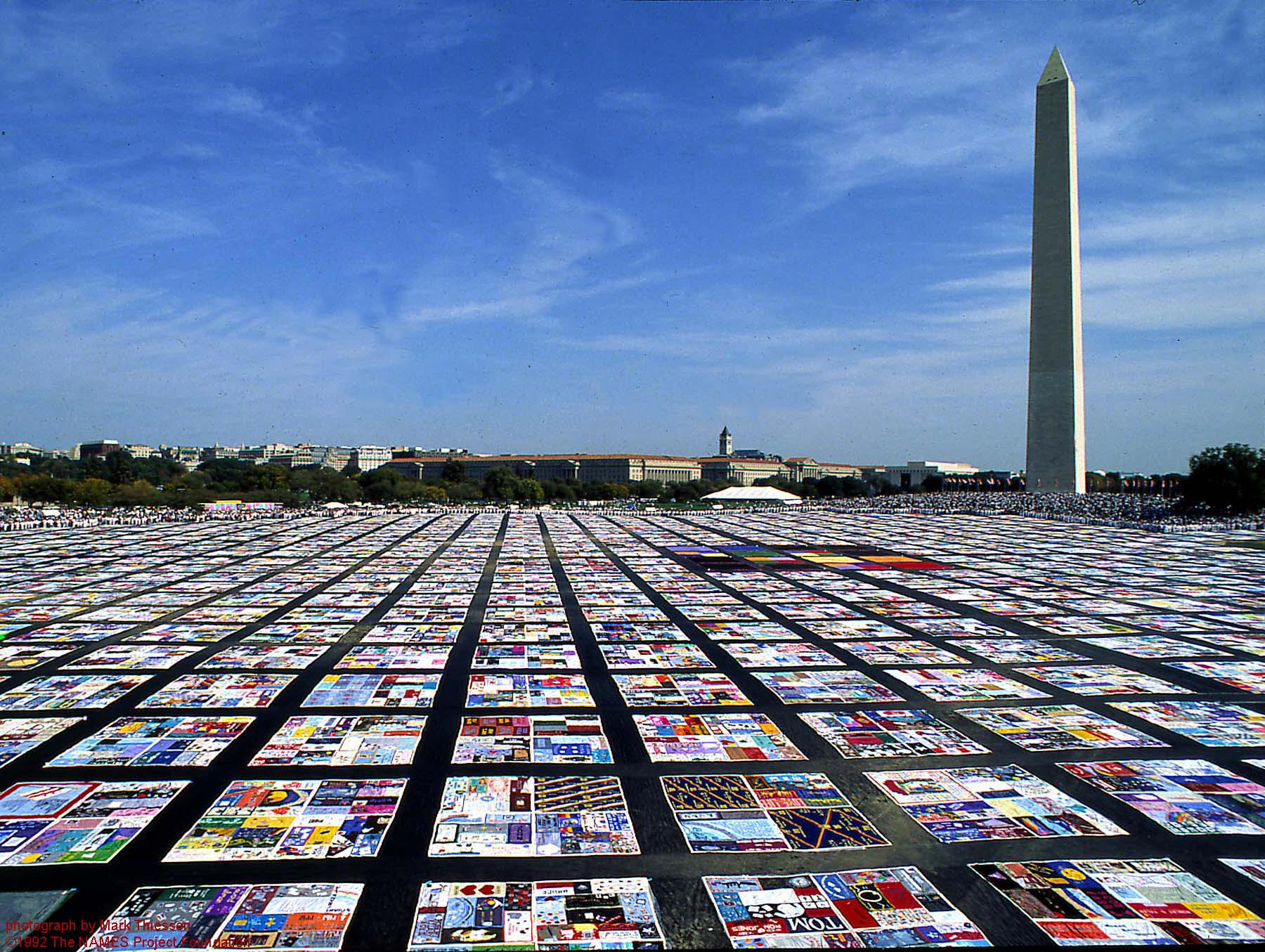
As of 2018, HIV/AIDS has killed about 700,000 people in the United States and has infected over one million. This epidemic, at the time of its height, inevitably killed those infected and caused immense social panic and unrest. The long-term debilitating effects of HIV infection and the onset of AIDS stigmatized drug users and the gay community. The NAMES Project AIDS Memorial Quilt, unveiled at the National Mall in Washington D.C., is a memorial to every American who has died of AIDS-related illnesses. It is the largest and heaviest memorial dedicated to a disease, measuring the equivalent of 24 football fields, that is made of more than 40,000 3 by 5 feet quilts dedicated to specific victims (Cortez).
(“NAMES Project AIDS Memorial Quilt.”)
How are memorials/monuments created?
For a historical event to become part of society’s collective memory, it requires the general public to actively want to commemorate or remember the event. A way to do this is to create a physical reminder of an important event, like a memorial/monument. However, there can be delays in the process of building memorials, such as designing one. Author Jeffrey L. Durbin makes a great point that “if we expect [a monument] to be permanent and to mark an especially solemn event, we want future generations to hold it with the same reverence that brought about its existence.” Public memorials often serve as places for reflection and solace during and after disasters, some even help people recover from traumatic events. Thus, it is important that a great amount of planning and research goes into building one.
Society has become increasingly influenced by the media and now entire countries can share the grief from tragedies that used to only affect those closest to the victim. In the aftermath of many disasters, temporary monuments often pop up first. Durbin suggests that the use of makeshift memorials has allowed strangers to cope with the sorrow for other strangers. Our new digital landscape of social media has made non-physical remembrances possible. Large physical gatherings continue to be mostly off-limits, so early forms of memorialization for the COVID-19 pandemic have begun virtually (Shoot). An example is the Twitter account @FacesOfCOVID created by Alex Goldstein which aims to track those lost during the pandemic via submitted accounts of personal stories about the victims.
COVID has no permanent memorial yet, so what would one look like?
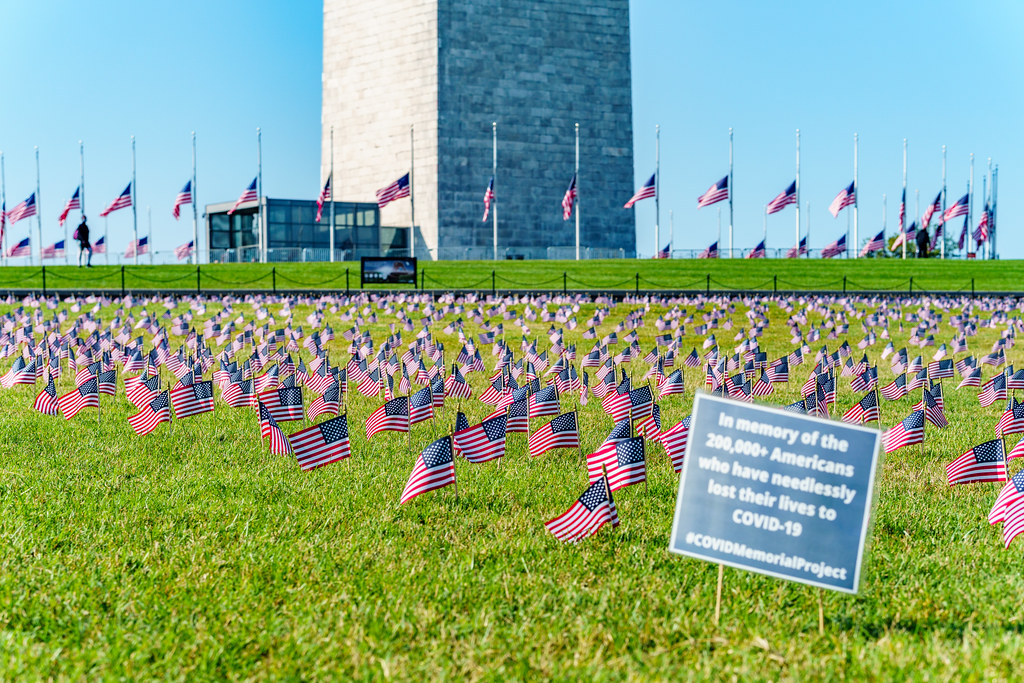
A temporary memorial for COVID-19 was created at the National Mall in Washington D.C. where 20,000 American flags were placed to honor the deaths of more than 200,000 victims (Godbey). As time goes on, the number of COVID-19 related deaths continue to increase. With these many deaths, it seems unreasonable and cliché to write every single name on one structure like a war monument and finding a location for a permanent installation can be difficult. Sometimes memorial sites can be predetermined in circumstances like a terrorist attack or natural disaster (Shoot). Dr. Emily Godbey, a professor of art and visual culture, mentions how massive disease outbreaks are also harder to conceptualize due to the sheer number of its victims, making them harder to publicly memorialize. This can be seen in the instance of the largely unnoticed 1918 Influenza pandemic.
Some artists have taken steps to plan for a possible installation, like Ronald Rael and Virginia San Fratello. Together they have a studio and pursue applied architectural research, putting more emphasis on the project making process than the product (Rael and Fratello). When asked on how to approach a design for a COVID-19 memorial, Ronald Rael wanted to create an experience that provided the lost physical touch and communion from quarantine. He looked to copper because it is an anti-microbial metal, it “collects human scent very well,” and develops a green or purple patina over time exposed to weather. The “metallic” smell typically associated with pennies is body odors, the same chemo-signals people transmit to each other when shaking hands or embracing. Rael thinks that having a memorial that invites physical touch can help people remember the moments that discouraged touch.
Similar to war monuments, such memorials represent a deeply human impulse to create a permanent reminder of those who have been lost.
Jeffrey L. Durbin
The impulse and necessity to memorialize is a natural one and must be taken seriously. Our current digital media landscape allows for an endless stream of “permanent” memorials even though it is non-physical. War memorials are often created to commemorate victims and any disease memorial should do the same. While it is unrealistic to memorialize specific individuals on one monument, Twitter accounts like @FacesofCOVID make that process much easier. Families and friends can submit stories about victims, facilitating a sense of connectedness and contribution as a means of grieving. A combination of a physical monument to record this moment in history and digital submissions of personal accounts of victims could create a happy medium to properly honor the lives that have been lost.
The COVID-19 pandemic is still relatively new, but many argue that it feels as though we have been living in an eternal nightmare. People have become exponentially tired of mask protocol and social distancing measures, wanting to forget about this time in our lives. However, we cannot and should not dishonor the three million COVID-related deaths recorded so far. We must learn from our forgetfulness of the 1918 Influenza Pandemic and the fifty million people who died that are scarcely respected with a small granite bench.
Works Cited
Cortez, Clifton J. “AIDS MEMORIAL QUILT: ABA AIDS Coordinating Committee Remembers Those Who Have Been Lost to the AIDS Pandemic.” Human Rights, vol. 24, no. 1, 1997, pp. 3–4. JSTOR, www.jstor.org/stable/27880014. Accessed 29 Apr. 2021.
Durbin, Jeffrey L. “EXPRESSIONS OF MASS GRIEF AND MOURNING: The Material Culture of Makeshift Memorials.” Material Culture, vol. 35, no. 2, 2003, pp. 22–47. JSTOR, www.jstor.org/stable/29764188. Accessed 15 Apr. 2021.
Godbey, Emily. “Will There Be a Monument to the COVID-19 Pandemic?” PBS, Public Broadcasting Service, 25 Nov. 2020, www.pbs.org/newshour/arts/will-there-be-a-monument-to-the-covid-19-pandemic.
Honigsbaum, Mark. “Why the 1918 Spanish Flu Defied Both Memory and Imagination.” Wellcome Collection, 25 Oct. 2018, wellcomecollection.org/articles/W7TfGRAAAP5F0eKS.
“Influenza.” Pandemics: A Very Short Introduction, by Christian W. McMillen, Oxford University Press, 2016, pp. 89–102.
Rael, Ronald, and Virginia San Fratello. “Covid 19 Memorial.” RAEL SAN FRATELLO, 2020, www.rael-sanfratello.com/ideas/covid-19-memorial.
Segal, David. “Why Are There Almost No Memorials to the Flu of 1918?” The New York Times, The New York Times, 14 May 2020, https://www.nytimes.com/2020/05/14/business/1918-flu-memorials.html
Shanken, Andrew. “Meet Me at the Plague Column: Monuments and Conservation Planning.” Future Anterior: Journal of Historic Preservation, History, Theory, and Criticism, vol. 14, no. 1, 2017, pp. 127–141. JSTOR, www.jstor.org/stable/10.5749/futuante.14.1.0127. Accessed 21 Apr. 2021.
Shoot, Britta. “The Rare Challenge of Building a Pandemic Memorial.” City Monitor, 9 June 2020, citymonitor.ai/community/the-rare-challenge-of-building-a-pandemic-memorial.
Images Cited
Bogost, Ian. “How Will the Future Remember COVID-19?” The Atlantic, Atlantic Media Company, 24 Nov. 2020, www.theatlantic.com/technology/archive/2020/11/what-should-a-covid-19-memorial-be/617137/.
Eytan, Ted. “2020.09.23 Covid Memorial Project, Washington, DC USA 267 17021.” Flickr, Yahoo!, 23 Sept. 2020, www.flickr.com/photos/taedc/50376810731.
Jarvis, Dennis. “Austria-00768 – Plague Column.” Flickr, Yahoo!, 3 Sept. 2015, www.flickr.com/photos/archer10/20880026670.
“NAMES Project AIDS Memorial Quilt.” Wikipedia, Wikimedia Foundation, 27 Apr. 2021, en.wikipedia.org/wiki/NAMES_Project_AIDS_Memorial_Quilt#/media/File:Aids_Quilt.jpg.
Segal, David. “Why Are There Almost No Memorials to the Flu of 1918?” The New York Times, The New York Times, 14 May 2020, https://www.nytimes.com/2020/05/14/business/1918-flu-memorials.html


